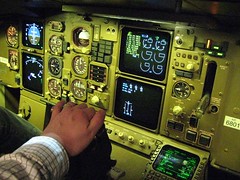The latest statement from the
NTSB on the Buffalo crash suggests the pilot simply let the airplane get too
slow. He then reacted badly and stalled the airplane. His reaction was seemingly
inexplicable for a professional pilot, as one of the first things you learn
during primary training is developing the muscle memory to break a still with
forward stick. I do not buy the notion proposed by some that the pilot
mistakenly thought he was dealing with an icing-induced tail plane stall. Even
though it is true that pulling back is proper for a tail plane stall (as
opposed to the typical main wing stall) absolutely nothing else the pilot did
was appropriate for a tail stall. Everything in the NTSB statement suggests the
cockpit simply devolved into complete chaos. While they mercifully keep this
out of the public eye, the NTSB investigators have suffered through listening
to the cockpit voice recorder and reading in between the lines of the NTSB
statement I think it’s fairly clear the pilot simply panicked.
However, I’m not passing
judgment. I’m sure I’d have done no better, even with all the training in the
world. My reason for writing this is to say something about the system, not the pilot. When
I was doing my instrument training, my biggest takeaway from the whole thing
was that it was utter bullshit for people’s lives to depend on a pilot doing it
correctly when the chips are down. It’s normally easy to fly on instruments,
but it gets surprisingly difficult quickly when things go wrong, especially
with the disorientation that occurs at night. Too much is expected of pilots
flying hard IFR in any airplane that’s not fully automated. Yes, it’s
manageable, but not with the kind of margin you’d like to see when lives are at
stake, and especially with relatively inexperienced pilots at the beginning of
their careers, as is the case with regional jet pilots. One’s ability to react
correctly is shockingly bad when terrified, and I’m guessing the slow speed
situation caught the pilots off guard and scared the shit out of them.
But don’t we live in a world
where automation and control technology has advanced to the point where the
space shuttle can deorbit and land itself? Where cars drive themselves on
highways and keep the car from spinning on ice? Why, then, are we paying to fly
our children in airplanes without something as relatively simple as
autothrottles, something that would’ve saved the lives of the families on the
Colgan Air flight? Why is this considered remotely acceptable? Why is “drop out of the sky and kill us
all” included in the set of possible control inputs to a commercial aircraft?
Apart from the Hudson ditching,
every major aviation
accident that’s happened in the past ten years in the US could have been
avoided with relatively straightforward control software, including 9/11.
If you don’t believe me, cite one and I’ll explain how simple software would’ve
avoided it. In the case of 9/11,
Given that this is all utterly
doable, why isn’t it done? The answer is that because of regulations and
liability, you can’t add a bloody toaster to a commercial aircraft for less
than $100,000 per plane. The idea of regulation and liability is that it should
keep us safe, but at this point thanks to the beauty of unintended consequences
and legislators that don’t seem to understand the concept of unintended
consequences, it is doing the exact opposite. The Dash 8 that killed those
people in Buffalo would’ve had autothrottles installed had they not been so
expensive, and that expense is caused largely by the regulators who make
certification so onerous, and the trial lawyers who make liability insurance
prohibitively expensive. The Dash 8 is exactly the kind of airplane that
needs them, but it won’t get them until we find a way to regulate aviation
without completely stifling technological advancement at the same time.
Because of this unintended
stifling effect, we could get rid of the FAA and safety would probably
increase. I know trusting souls out there gasp at this idea, but the FAA is
essentially an extension of the airline industry, anyway, so what we have now
is basically self-regulation with all the disadvantages of government
efficiency. They don’t have the guts to do anything drastic, and almost never
have the brains to not do harm. They’ll focus on the small stuff (remember the
Boeing 727 wiring inspections a while back?) and completely drop the ball on
the big problems. When the FAA found out that the Boeing 737 had a major issue
whereby the rudder would hard-over on its own, a problem that occurred over 100
times and caused two major fatal crashes, did they ground the fleet? Nope. That
would’ve been too financially disruptive. They simply told the airlines to fly the planes a bit faster
so that pilots could have a better chance at recovery when it happened.
Sometimes the only difference
between free market anarchy and government regulation is paperwork.
